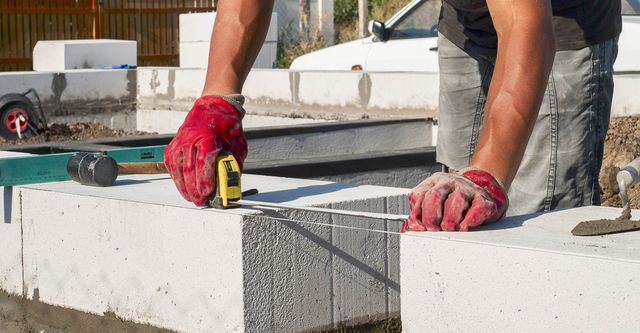Unlocking the Tricks of Lasting Stonework Building And Construction Practices for Eco-Friendly Buildings
In the realm of modern-day construction, the pursuit of sustainable methods has actually come to be paramount. Among the myriad techniques to environmentally friendly structure, lasting masonry construction stands apart as a tried and true and long lasting technique that holds a riches of untapped capacity. From the option of products to ingenious building methods, the tricks to accomplishing sustainability within masonry construction are diverse and intriguing. By checking out the benefits, materials, techniques, and future fads of lasting stonework, a deeper understanding of exactly how these practices can shape the future of environmentally friendly buildings emerges.
Benefits of Lasting Stonework Building And Construction
Embracing sustainable stonework building techniques not just decreases ecological impact but likewise uses lasting economic benefits to home builders and areas. By utilizing materials like recycled blocks, obstructs, and stones, building contractors can dramatically decrease the carbon footprint of their projects while promoting resource effectiveness. Additionally, lasting stonework building strategies, such as proper insulation and thermal mass residential or commercial properties, can improve power performance within structures, leading to reduced operational costs over time.
In addition, the toughness and durability of stonework structures contribute to long-lasting economic benefits. Buildings constructed using sustainable masonry practices often require much less repair and maintenance, converting to set you back financial savings for building contractors and home owners. The durability of masonry products additionally makes sure that frameworks stay steady and protected, reducing the demand for constant restorations or replacements.
Eco-Friendly Masonry Products
Using green stonework products is an essential action in the direction of improving the sustainability of building techniques and minimizing environmental influence while maximizing long-lasting economic benefits. Sustainable masonry materials are sourced, created, and made use of in a fashion that reduces overall environmental influence. Lasting concrete obstructs incorporate recycled aggregates and may feature improved insulation buildings, adding to power efficiency in buildings.
Additionally, natural materials like adobe, rammed earth, and straw bales offer exceptional thermal mass residential properties, reducing the need for home heating and cooling power. These products are commonly locally readily available, advertising local economic situations and lowering transportation-related carbon exhausts. By picking environmentally friendly masonry products, building and construction tasks can considerably decrease their environmental impact and add to the development of healthier, much more sustainable constructed environments.
Energy-Efficient Masonry Strategies
Power effectiveness plays a vital role in boosting the sustainability of masonry building and construction practices. One vital energy-efficient masonry method is the use of thermal mass, which entails including dense materials like concrete or block into the building's framework to absorb and keep heat.

Technologies in Lasting Masonry
Recent improvements in lasting masonry methods have brought about innovative techniques that are reshaping the construction sector. One such technology is the development of self-healing concrete, which uses germs embedded within the concrete to heal splits autonomously. This innovation not just minimizes maintenance prices yet likewise enhances the resilience of masonry frameworks, adding to their sustainability.
Another notable technology is making use of recycled accumulations in masonry construction - masonry contractor. By including products such as crushed ceramic waste or recycled glass right into concrete mixes, contractors can reduce the ecological impact of construction tasks while preserving weblink structural stability. This practice not just diverts waste from land fills however also preserves natural sources, making it a crucial advancement in lasting masonry building and construction
Additionally, the integration of electronic design devices, such as Building Details Modeling (BIM), is reinventing the way stonework frameworks are prepared and created. BIM permits more exact calculations, lowered material wastefulness, and improved power efficiency, eventually bring about more lasting building practices. These developments jointly signify a promising future for sustainable stonework construction in the age of eco-friendly structures.
Future Trends in Masonry Sustainability
With the ingenious strides made in lasting stonework practices, the future patterns in stonework sustainability are positioned to more transform the building sector. Among the essential fads forming the dealerships future of stonework sustainability is the enhanced combination of modern technology. Advancements such as Building Info Modeling (BIM) and digital fact simulations are being utilized to optimize masonry building procedures, bring about reduced product waste and improved energy efficiency in buildings.
Additionally, the development of novel sustainable products is set to play a significant role in improving the eco-friendliness of stonework building and construction. masonry contractor. Technologies like self-healing concrete, recycled accumulations, and bio-based binders are acquiring traction for their ability to reduce ecological influence while preserving architectural stability

Final Thought
Finally, sustainable stonework building techniques use numerous advantages for environmentally friendly structures. By using eco-friendly products and energy-efficient strategies, masonry can add to an extra sustainable constructed environment. Technologies in sustainable stonework are see this page continuously being established to further improve the environmental efficiency of buildings. Looking in the direction of the future, the trend of masonry sustainability is anticipated to grow, causing more ecologically friendly and energy-efficient building and construction practices in the years to find.